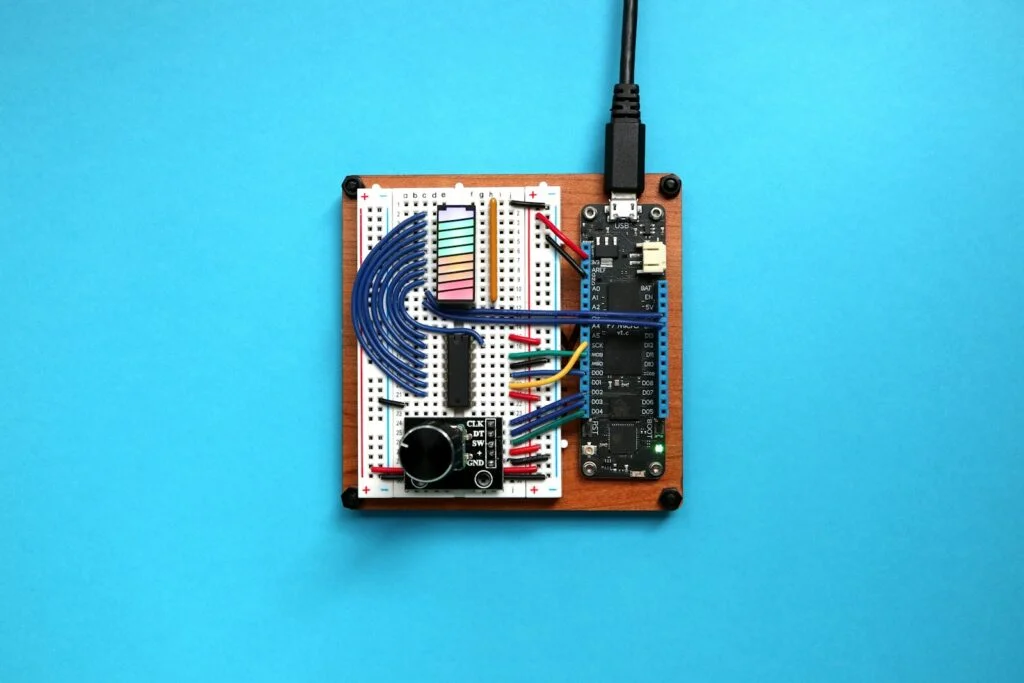
By Nicolás Longo
(As an Amazon Associate we earn from qualifying purchases)
Discover the Advantages of Barometric Pressure Sensors
Barometric Pressure Sensors have become essential components in numerous applications—from weather stations and altimeters to automotive systems and smart home devices. These sensors measure atmospheric pressure and convert that information into electrical signals, providing critical data for various industries. Whether you’re a hobbyist interested in meteorology or an engineer upgrading your equipment, investing in reliable Barometric Pressure Sensors can optimize your project performance and safety.
Barometric Pressure Sensors not only deliver accurate measurements but also help in predicting weather changes and maintaining efficient operations in devices. Their integration in portable electronics, automotive monitoring systems, and industrial equipment demonstrates their versatility and indispensability. For instance, in aviation, precise barometric readings are vital for accurate altitude determination, while in the automotive industry, they assist in improving fuel efficiency and safety.
A Brief Overview of Barometric Pressure Sensors
The technology behind Barometric Pressure Sensors has evolved significantly over recent decades. Initially used in basic weather prediction, these sensors now employ advanced microelectromechanical systems (MEMS) technology to achieve high accuracy with low power consumption. Their compact design makes them perfect for integration into smartphones, wearable devices, and remote sensing systems. Recent innovations have enhanced their reliability and response time, ensuring that even minor pressure changes are captured accurately.
Modern Barometric Pressure Sensors use various methods such as piezoelectric, capacitive, or resonant sensing techniques. The choice of sensor depends on the application requirements for precision, durability, and environmental resistance. Experts recommend evaluating factors such as measurement range, resolution, and operating temperature to select the ideal sensor for your needs.
Key Applications and Benefits
Understanding the applications of Barometric Pressure Sensors can help you appreciate their wide-reaching benefits. These sensors are pivotal in meteorological equipment, where they monitor atmospheric pressure changes to forecast weather conditions. In aviation, they are fundamental for altimeters and autopilot systems, ensuring safe flight operations. Additionally, in automotive systems, Barometric Pressure Sensors play a role in engine management and tire pressure monitoring, thereby improving fuel efficiency and performance.
Beyond these, Barometric Pressure Sensors are also employed in consumer electronics. For example, many smartwatches and fitness trackers incorporate these sensors to provide users with real-time altitude and weather updates. Their low power consumption and miniaturized design have spurred further innovation, allowing for the development of energy-efficient and compact devices.
Technical Insights and Innovations
One of the most impressive aspects of Barometric Pressure Sensors is their ability to provide high-resolution data even with minute pressure differences. Recent advancements have enabled sensors to achieve resolutions down to a few centimeters of water, crucial for precision applications like drone navigation and medical devices. Researchers continuously work on enhancing sensor accuracy and reducing error margins through innovative materials and design techniques.
Additionally, the integration of digital interfaces with Barometric Pressure Sensors has simplified data processing and connectivity. This enables seamless communication with microcontrollers and cloud systems, allowing for real-time monitoring and analysis. Such innovations not only improve the performance of these sensors but also expand their potential in IoT (Internet of Things) applications.
How to Choose the Best Barometric Pressure Sensors
When selecting Barometric Pressure Sensors, consider these important factors:
- Accuracy and Resolution: Look for sensors that offer high precision and can detect small changes in pressure.
- Power Consumption: Opt for models with low energy requirements, especially for portable and battery-operated devices.
- Operating Environment: Ensure the sensor can function reliably under the temperature and humidity conditions of your application.
- Interface and Compatibility: Check for digital output options and ease of integration with your existing systems.
- Durability and Build Quality: Invest in sensors with robust construction to guarantee longevity, particularly in industrial or harsh environments.
Technical reviews and expert testimonials can provide additional insights into the performance of different Barometric Pressure Sensors. It’s also advisable to compare product specifications and manufacturer warranties to make an informed decision.
The Future of Barometric Pressure Sensors
The role of Barometric Pressure Sensors is expanding as industries continue to embrace automation and smart technologies. Their integration into environmental monitoring systems, autonomous vehicles, and wearable devices highlights the growing demand for precise and reliable sensors. With ongoing research and development, we can expect further improvements in sensor accuracy, miniaturization, and energy efficiency. This evolution will not only boost product performance but also pave the way for innovative applications in emerging technologies.
Practical Tips for Maintenance and Calibration
To ensure optimal performance of your Barometric Pressure Sensors, regular maintenance and calibration are crucial. Follow the manufacturer’s guidelines for cleaning and recalibrating the sensors to maintain their accuracy. In many cases, environmental factors such as dust and humidity can affect sensor readings, so proper housing and periodic recalibration can help avoid inaccuracies.
For users in industries where precision is key, investing in calibration tools or services can be a worthwhile expense. Regular testing against known pressure standards will ensure that your Barometric Pressure Sensors continue to deliver reliable data throughout their operational life.
Cost-Effectiveness and Return on Investment
Although high-quality Barometric Pressure Sensors may require a higher initial investment, their durability and precision often translate into significant long-term savings. Reduced maintenance costs, fewer system failures, and improved operational efficiency contribute to a favorable return on investment. In critical applications like aviation and automotive systems, the reliability of these sensors can even enhance safety, making them indispensable despite the cost.
Many businesses and hobbyists alike have reported that upgrading to advanced Barometric Pressure Sensors has led to measurable improvements in performance and energy efficiency. Customer reviews on trusted platforms and technical case studies are excellent resources to verify the benefits and reliability of different sensor models.
Top 10 Best Barometric Pressure Sensors to Buy
- BMP180 is a high-precision, small size, ultra-low power pressure sensor that can be used in mobile devices, to measure t…
- Its performance excellence, the absolute accuracy of the lowest can reach 0.03hPa, and low power consumption, only 3μA.
- BMP180 uses a powerful 8-pin leadless ceramic chip can be directly connected with a variety of microprocessor via I2C.

- It is an environmental sensor with temperature, barometric pressure that is the next generation upgrade to the BMP085/BM…
- The BMP280 is an absolute barometric pressure sensor especially designed for mobile.
- This sensor is great for all sorts of weather sensing and can even be used in both I2C and SPI!

- The BMP390L has better precision than ever, which makes it excellent for environmental sensing or as a precision altimet…
- This sensor has a relative accuracy of ± 3 Pascals, which translates to about ± 0.25 meters of altitude (compare to the …
- The surface-mount sensor is soldered onto a custom made PCB in the STEMMA QT form factor, making them easy to interface …

- Digital Barometric Pressure Sensor Module
- It adopts a high-precision AD sampling chip
- It can detect the air pressure and water level also

- BMP180 is a high-precision, small size, ultra-low power pressure sensor that can be used in mobile devices
- Its performance excellence, the absolute accuracy of the lowest can reach 0.03hPa, and low power consumption, only 3μA
- BMP180 powerful 8-pin ceramic leadless chip carrier (LCC) ultra-thin package, you can directly through the I2C bus conne…

- This module adopts high precision AD sampling chip and 0-40KPa air pressure sensor.
- Adopts 5K ohm resistor bridge sensor.
- Pressure: 0-40KPa., Voltage: 3.3-5V. The specific air pressure value needs to be calculated

- The BMP390 is a 24-bit absolute barometric pressure sensor, with the features of ultra-small form factor, low power cons…
- Onboard BMP390 sensor for measuring barometric pressure, altitude and temperature
- Supports I2C communication, I2C address configurable, with I2C bus cascading support. Supports SPI communication, enable…

- Pressure: 0-40KPa., Voltage: 3.3-5V. The specific air pressure value needs to be calculated
- Voltage: 3.3-5V
- Adopt 5K ohm resistor bridge sensor, and specific air pressure value needs calculating.

- Enhanced Safety: This intake pressure sensor, equipped with advanced production technology, ensures high accuracy and se…
- Durability: Crafted from premium materials, this intake pressure sensor guarantees maximum durability and consistent per…
- Universal Compatibility: Compatible with various brands, offering versatility for different machine
- GM-recommended replacement part for your GM vehicle’s original factory component
- Offering the quality, reliability, and durability of GM OE
- Manufactured to GM OE specification for fit, form, and function

Selecting the right Barometric Pressure Sensors can dramatically enhance the accuracy and efficiency of your projects. From aerospace to consumer electronics, these sensors are vital for obtaining precise atmospheric data. With modern innovations, there is a vast array of options available that cater to various technical and budgetary requirements. The right sensor will not only meet your current needs but also adapt to future technological advancements, ensuring that you stay ahead in a competitive market.
“As an Amazon Associate we earn from qualifying purchases.”







































































